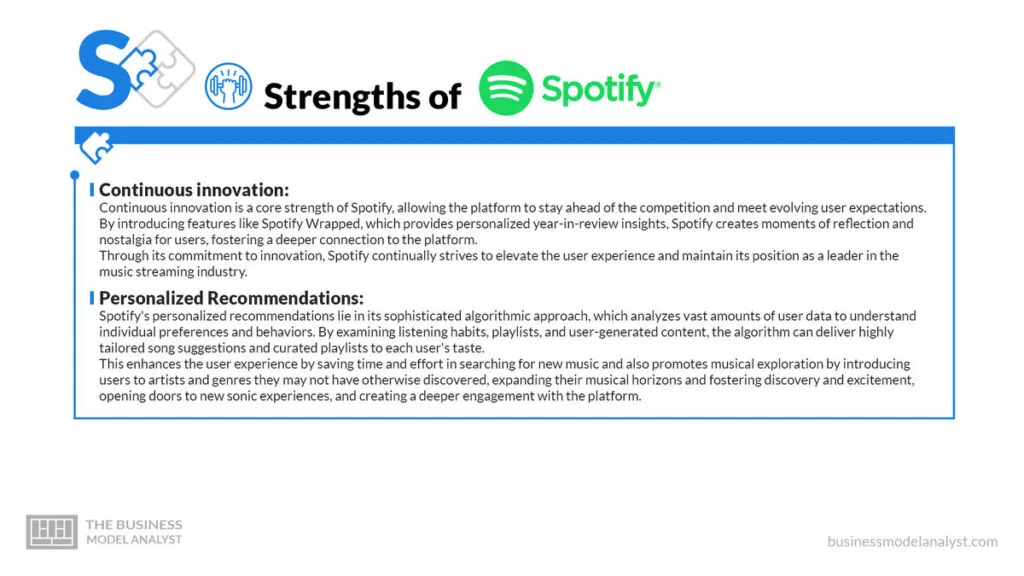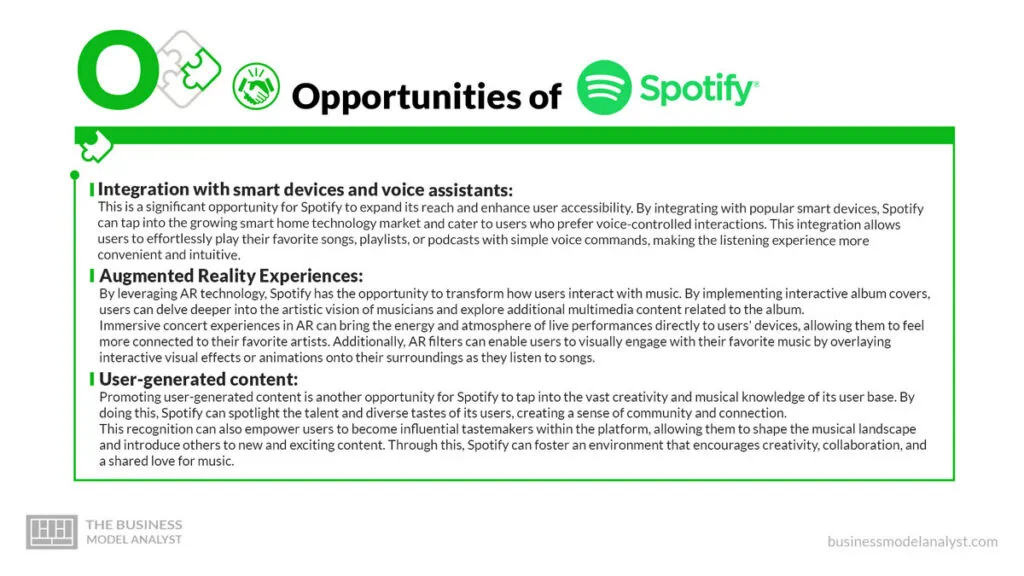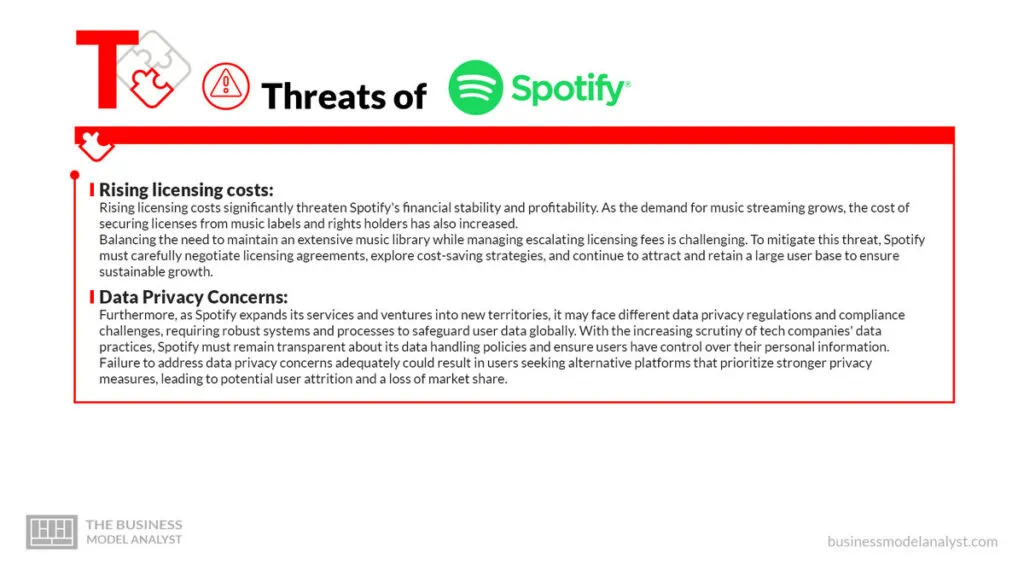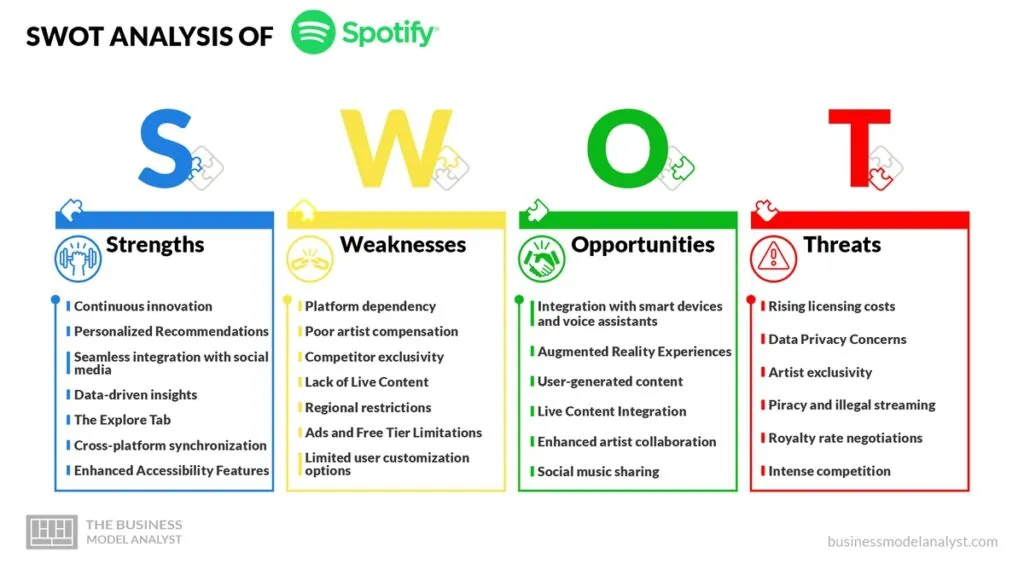Spotify is a leading global audio streaming platform that revolutionized how people listen to music and podcasts. Founded by Daniel Ek and Martin Lorentzon, Spotify was launched in Stockholm, Sweden, in April 2006. It quickly gained popularity for its user-friendly interface, vast music library, and innovative features that allowed users to stream music legally and easily.
Spotify has grown into a powerhouse with over 500 million active users and over 8 million artists on its platform. The company operates in over 170 countries and has expanded its services to include music, podcasts, and audiobooks.
One of its early successes was its ability to secure licensing agreements with major record labels, ensuring a vast catalog of songs for users. It introduced personalized playlists like Discover Weekly and Release Radar, leveraging algorithms to curate customized music recommendations. However, the company also faced initial challenges, such as negotiating licensing deals and competing against established players in the music industry.
Despite these hurdles, Spotify‘s dedication to continuous innovation and user-centric features propelled its growth. It introduced popular features like collaborative playlists, offline listening, and the Spotify Wrapped year-end review, creating a highly engaging and interactive platform for music lovers.
Today, Spotify is not only synonymous with music streaming but has also become a major player in the podcasting industry, with exclusive content deals and its podcast creation platform, Spotify for Podcasters. With its immense user base, global reach, and commitment to enhancing the audio streaming experience, Spotify remains at the forefront of the digital music and podcasting revolution.
Below, there is a detailed Spotify SWOT Analysis to better understand its strengths, weaknesses, opportunities, and threats in the global market.
Contents
Spotify Strengths

With its user-friendly interface and personalized recommendations, Spotify offers a seamless and enjoyable music listening experience for casual and enthusiasts alike. Below, there are some of its strengths:
Continuous innovation
Continuous innovation is a core strength of Spotify, allowing the platform to stay ahead of the competition and meet evolving user expectations. By introducing features like Spotify Wrapped, which provides personalized year-in-review insights, Spotify creates moments of reflection and nostalgia for users, fostering a deeper connection to the platform.
Through its commitment to innovation, Spotify continually strives to elevate the user experience and maintain its position as a leader in the music streaming industry.
Personalized Recommendations
Spotify’s personalized recommendations lie in its sophisticated algorithmic approach, which analyzes vast amounts of user data to understand individual preferences and behaviors. By examining listening habits, playlists, and user-generated content, the algorithm can deliver highly tailored song suggestions and curated playlists to each user’s taste.
This enhances the user experience by saving time and effort in searching for new music and also promotes musical exploration by introducing users to artists and genres they may not have otherwise discovered, expanding their musical horizons and fostering discovery and excitement, opening doors to new sonic experiences, and creating a deeper engagement with the platform.
Seamless integration with social media
The platform’s seamless integration with popular social media platforms is another notable strength.
By allowing users to share their favorite songs, playlists, and recently played tracks with friends and followers, Spotify creates a vibrant environment for music discovery and sharing, facilitating the exploration of new music through social connections, but also fosters a sense of musical community as users engage in conversations, exchange recommendations, and discover new artists together.
This combination forms a powerful synergy, transforming Spotify into a platform where users can find music tailored to their taste and connect with other like-minded people.
Data-driven insights
The data-driven insights provided by Spotify give artists a valuable understanding of their listenership on a granular level. By analyzing demographics, artists can gain insights into the age, gender, and interests of their fan base, enabling them to tailor their music and marketing strategies accordingly.
This helps them plan tours, target specific regions for promotion, and connect with fans in different parts of the world. Moreover, streaming patterns provide artists with valuable information about which songs resonate most with their audience, allowing them to focus on creating similar content that appeals to their fan base.
The Explore Tab
The Explore tab in Spotify is a gateway to a world of musical exploration and discovery. Through curated playlists, genres, and charts, users can easily navigate through various musical choices, expanding their musical horizons beyond their usual preferences. This curated selection helps users stay updated with the latest trends and discover new and emerging artists across various genres.
The Explore tab also offers a convenient and organized approach to exploring different moods, themes, and musical styles. Users can delve into specific genres they are interested in, discover playlists tailored to different activities or moods, and stay informed about the top songs and albums globally.
Cross-platform synchronization
Spotify’s cross-platform synchronization feature enhances user convenience and flexibility. Whether transitioning from a smartphone to a computer or switching between different devices throughout the day, Spotify seamlessly picks up where the user left off, eliminating the need to search for the last played song or playlist.
This synchronization extends to various devices, including smartphones, tablets, computers, smart TVs, and web browsers, enabling users to access their music library and playlists effortlessly regardless of their device and enjoy uninterrupted music across their preferred devices.
Enhanced Accessibility Features
Spotify’s commitment to accessibility is evident through its provision of enhanced accessibility features. By offering support for screen readers, individuals with visual impairments can navigate and enjoy the platform using assistive technologies that convert on-screen text into speech.
Also, text resizing options cater to users with visual difficulties, allowing them to adjust the font size for better readability. Its optimized interfaces for users with visual impairments ensure a user-friendly experience by focusing on clear layouts, contrasting colors, and intuitive navigation.
Enhanced deliverability
Another strength is enhanced discoverability features that empower users to uncover new music and dive deeper into their musical preferences. “Song Radio” takes a single song and generates a personalized radio station, introducing users to similar tracks and artists they may not have encountered before, allowing for serendipitous discoveries and expanding users’ musical horizons.
The “On Repeat” and “Repeat Rewind” features offer a glimpse into the user’s musical habits and favorites. “On Repeat” showcases the tracks currently in heavy rotation, while “Repeat Rewind” highlights previously loved songs. These features provide users with a curated snapshot of their music taste and allow them to rediscover beloved tracks.
Podcast monetization
Spotify’s podcast monetization initiatives have revolutionized the industry by offering content creators opportunities to generate revenue from their podcasts. The platform enables creators to monetize their shows by incorporating ads that align with their content and target their specific audience. This advertising revenue model provides a sustainable way for podcasters to support their productions and continue delivering high-quality content to listeners.
Moreover, Spotify has struck exclusive podcast deals with notable creators, such as financial incentives and benefits, offering content creators a unique opportunity to monetize their podcasts while gaining exposure to a vast listener base on the platform.
Spotify Weaknesses

Despite its extensive library, Spotify still has limitations on the availability of certain artists, albums, or songs due to licensing agreements or exclusivity deals, which can be disappointing for users with specific preferences. Here are more details about Spotify’s weaknesses.
Platform dependency
Platform dependency is a major weakness as it exposes users to potential disruptions and limitations. Any technical issues, such as app crashes or server outages, can hinder users’ ability to access their music library or stream songs. This dependency leaves users vulnerable to downtime or service interruptions, impacting their overall experience.
Moreover, compatibility issues may arise if Spotify discontinues support for specific operating systems or devices, forcing users to upgrade or find alternative music streaming platforms and limiting users’ flexibility and freedom.
Poor artist compensation
Spotify’s artist compensation model has received criticism from artists and industry professionals alike, citing concerns about the relatively low royalty rates paid out to artists. This disparity in compensation has ignited debates about the fair distribution of revenue in the music industry and the economic sustainability of musicians.
Some argue that the streaming model heavily favors popular artists, leaving lesser-known and emerging artists struggling to earn a livable income. Furthermore, the complex nature of royalty calculations and the involvement of intermediaries in the distribution process have also been points of contention.
Competitor exclusivity
Competitor exclusivity poses a challenge for Spotify as it can lead to a fragmented user experience. Exclusive content or deals offered by competing platforms may incentivize users to switch between streaming services to access specific artists, albums, or exclusive releases.
This fragmentation can be inconvenient and potentially diminish user loyalty toward Spotify. To mitigate this weakness, Spotify has sought to counter exclusivity by investing in original content, exclusive podcast deals, and artist collaborations.
Lack of Live Content
The absence of live content on Spotify means that users may need to rely on other platforms or services to access live radio broadcasts or stream live concerts and events. This content fragmentation can be inconvenient for users who prefer a consolidated and all-encompassing music streaming experience.
To remain competitive in the streaming market, Spotify may need to explore partnerships or develop its live content offerings to address this limitation and meet the evolving demands of its user base.
Regional restrictions
Spotify’s regional restrictions can be a drawback for users, as the availability of features and content may vary based on their geographical location. Certain countries may have limited access to specific features, such as podcasts, or may face delays in releasing new music due to licensing agreements and regional restrictions, creating an uneven user experience globally.
As such, Spotify could work towards expanding its licensing agreements and negotiating the global availability of features and content, ensuring a more consistent and inclusive user experience across different regions.
Ads and Free Tier Limitations
The presence of ads on the free tier of Spotify can be intrusive and disrupt the seamless listening experience for non-paying users. These ads, though necessary for supporting the platform, can be an interruption and negatively impact overall user satisfaction.
Moreover, the limitations imposed on the free tier, such as limited song skips and the lack of offline listening, restrict the flexibility and convenience that free subscribers enjoy but also incentivize users to upgrade to the premium subscription to access a more enhanced and uninterrupted listening experience.
Limited user customization options
The limited user customization options on Spotify can be a drawback for users who desire more control over their music listening experience. While Spotify’s algorithms are designed to provide personalized recommendations, some users may wish for more granular control, such as the ability to fine-tune their preferences or exclude certain artists or genres.
Offering greater user customization features can enhance the platform’s appeal and cater to the diverse preferences of its user base, potentially increasing user satisfaction and engagement.
Spotify Opportunities

Spotify has embraced opportunities to facilitate artist collaborations and secure exclusive releases. By partnering with artists and offering exclusive content, Spotify creates a unique and desirable user experience. Below, there are more details about the opportunities Spotify can take advantage of.
Integration with smart devices and voice assistants
This is a significant opportunity for Spotify to expand its reach and enhance user accessibility. By integrating with popular smart devices, Spotify can tap into the growing smart home technology market and cater to users who prefer voice-controlled interactions. This integration allows users to effortlessly play their favorite songs, playlists, or podcasts with simple voice commands, making the listening experience more convenient and intuitive.
Augmented Reality Experiences
By leveraging AR technology, Spotify has the opportunity to transform how users interact with music. By implementing interactive album covers, users can delve deeper into the artistic vision of musicians and explore additional multimedia content related to the album.
Immersive concert experiences in AR can bring the energy and atmosphere of live performances directly to users’ devices, allowing them to feel more connected to their favorite artists. Additionally, AR filters can enable users to visually engage with their favorite music by overlaying interactive visual effects or animations onto their surroundings as they listen to songs.
User-generated content
Promoting user-generated content is another opportunity for Spotify to tap into the vast creativity and musical knowledge of its user base. By doing this, Spotify can spotlight the talent and diverse tastes of its users, creating a sense of community and connection.
This recognition can also empower users to become influential tastemakers within the platform, allowing them to shape the musical landscape and introduce others to new and exciting content. Through this, Spotify can foster an environment that encourages creativity, collaboration, and a shared love for music.
Live Content Integration
Live content integration presents a significant opportunity for Spotify to elevate the user experience and create a sense of immediacy. By offering live radio, users can tune in to real-time broadcasts, participate in interactive shows, and stay connected to the latest news, interviews, and music events.
Furthermore, live-streaming of concerts and events would allow users to virtually attend live performances, expanding access to exclusive shows and creating a more interactive experience. This integration of live content can enhance user engagement and retention on the platform.
Enhanced artist collaboration
Enhanced artist collaboration is an exciting opportunity for Spotify to foster creativity and produce unique content that resonates with users. Therefore, Spotify can showcase diverse and innovative musical collaborations that push boundaries and blend genres, positioning it as a platform that actively supports and encourages artistic collaboration.
Such collaborations can attract a wider audience and increase engagement on the platform, as users eagerly anticipate and explore the results of these dynamic partnerships.
Social music sharing
Social music sharing can help to strengthen Spotify’s social features and enhance user engagement. In light of this, users can come together to curate and contribute to a shared musical experience, fostering a sense of community and collaborative interactions.
More so, group listening sessions can enable users to listen to music simultaneously with friends or family, regardless of physical location, creating virtual listening parties and facilitating shared moments. These social sharing features also encourage the discovery and exploration of new music through shared recommendations and musical conversations.
Spotify Threats

One of the major threats Spotify faces is shifts in consumer preferences, emerging technologies, and evolving business models. Others include:
Rising licensing costs
Rising licensing costs significantly threaten Spotify’s financial stability and profitability. As the demand for music streaming grows, the cost of securing licenses from music labels and rights holders has also increased.
Balancing the need to maintain an extensive music library while managing escalating licensing fees is challenging. To mitigate this threat, Spotify must carefully negotiate licensing agreements, explore cost-saving strategies, and continue to attract and retain a large user base to ensure sustainable growth.
Data Privacy Concerns
Furthermore, as Spotify expands its services and ventures into new territories, it may face different data privacy regulations and compliance challenges, requiring robust systems and processes to safeguard user data globally. With the increasing scrutiny of tech companies’ data practices, Spotify must remain transparent about its data handling policies and ensure users have control over their personal information.
Failure to address data privacy concerns adequately could result in users seeking alternative platforms that prioritize stronger privacy measures, leading to potential user attrition and a loss of market share.
Artist exclusivity
Artist exclusivity deals significantly threaten Spotify’s content availability and user retention. When artists or labels opt to release their music exclusively on other streaming platforms, it restricts Spotify’s access to that content, potentially leaving users unable to find their favorite artists or albums on the platform.
This exclusivity can create a fragmented user experience, leading to user dissatisfaction and a potential loss of engagement and loyalty. To solve this, Spotify must actively negotiate and secure partnerships with artists and labels, encouraging them to release their music on the platform and ensuring a diverse music library.
Piracy and illegal streaming
Piracy and illegal streaming is another threat. If users can easily access copyrighted music for free through illegal channels, it undermines the value proposition of paid subscriptions and hampers Spotify’s ability to generate revenue from its services.
The widespread availability of pirated music can diminish the perceived need for legitimate streaming services, potentially leading users to abandon or avoid paying for Spotify’s offerings. Therefore, Spotify must continue its efforts to combat piracy, enforce copyright protection, and educate users about the importance of supporting artists through legal streaming platforms.
Royalty rate negotiations
Another major threat is royalty rate negotiations. As the streaming platform relies on licensing agreements with music labels and rights holders, any substantial increase in royalty rates could significantly impact Spotify’s profitability.
If the cost of licensing music rises significantly, Spotify may face financial pressure that could necessitate adjustments, such as raising subscription prices to maintain profitability. However, increased subscription prices could potentially lead to user attrition if users perceive the service as less cost-effective compared to competing platforms.
Intense competition
The intense competition in the music streaming industry poses a significant threat to Spotify’s market position. Competitors like Apple Music, Amazon Music, and YouTube Music have substantial financial resources and established user bases, allowing them to invest in marketing, exclusive content, and technological advancements.
This competition pressures Spotify to innovate and differentiate itself to attract and retain users continuously. Furthermore, as these competing platforms continue to expand their offerings and improve their services, Spotify risks losing market share and growth opportunities if it fails to compete and adapt to evolving consumer preferences effectively.
Conclusion
In conclusion, Spotify has established itself as a dominant force in the music streaming industry, leveraging its strengths, such as personalized recommendations, integration with social media, and data-driven insights for artists. The platform has revolutionized how people discover, stream, and share music, creating a vibrant and inclusive community of music enthusiasts.
However, Spotify also faces challenges and threats, including intense competition, concerns around artist compensation, and the need to address data privacy issues. To maintain its position and drive future growth, Spotify must continue to innovate, expand its offerings, and adapt to evolving consumer preferences.
Opportunities such as enhanced artist collaboration, podcast monetization, and live content integration present avenues for Spotify to capitalize on and further engage its users. By navigating these challenges and seizing opportunities, Spotify can continue to shape the future of music streaming, providing users with a seamless, personalized, and enriching music experience.


